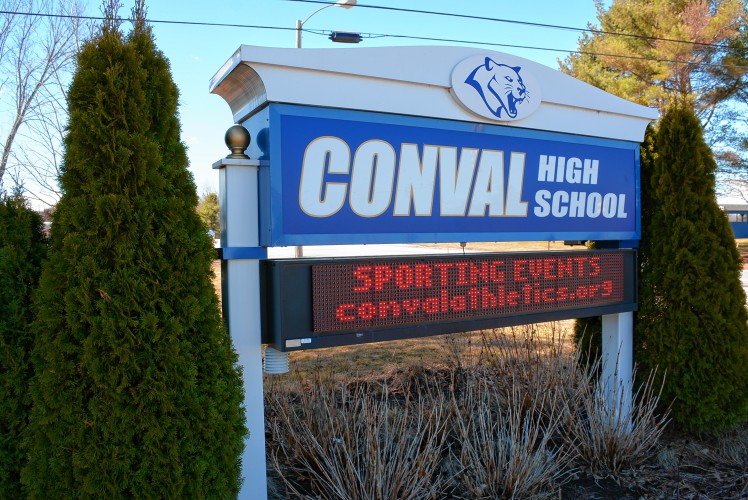Judge in ConVal funding case says decision could be soon

ConVal High School. FILE PHOTO
| Published: 07-18-2023 3:36 PM |
Judge David Ruoff of Rockingham County Superior Court, whose docket includes two challenges to the state’s scheme of funding its public schools, has indicated that decisions in one or both of the cases could be forthcoming within the next 60 days.
In May, Ruoff heard closing arguments in the suit initially filed by the ConVal School District in 2019 claiming that the state has failed to fulfill its constitutional obligation to pay for the adequate education of every child. Both parties appealed Ruoff’s decision to the NH Supreme Court, which in 2021 reversed his order and remanded the case for a second trial, which ended this spring and remains to be decided.
Meanwhile, in June 2022 attorneys Andru Volinsky, John Tobin and Natalie LaFlamme filed suit on behalf of Steven Rand, a business owner from Plymouth, and five other property taxpayers, charging that local school property taxes along with the statewide education property tax (SWEPT), which together fund some 70 percent of education expenditures, are both unconstitutional.
The Rand suit echoes the ConVal suit by claiming the state calculation of the cost of an adequate education is a fraction of its actual cost, leaving local school property taxes to fund the shortfall. However, the ConVal plaintiffs have asked the court to determine the cost of a constitutionally adequate education and provide sufficient funding without directly addressing the issue of taxation.
The Rand plaintiffs, on the other hand, claim both local school property taxes and SWEPT are illegitimate means of funding the state’s obligation to provide constitutionally adequate public education. Both taxes, the plaintiffs argue, violate the order of the NH Supreme Court, which, in the Claremont decision of 1997, held that “To the extent the State relies upon property taxes to fund a constitutionally adequate public education, the tax must be administered in a manner that is equal in valuation and uniform in rate throughout the State.”
Shortly after bringing suit, the Rand plaintiffs fastened on the SWEPT as the low-hanging fruit by filing a motion to enjoin the tax for the 2023 tax year. Ruoff denied the motion, which he found would disrupt the processes of setting municipal tax rates and preparing municipal budgets already underway. Since then, both the plaintiffs and the state filed motions for summary judgment. Ruoff acknowledged that the facts surrounding the administration of the SWEPT are not in dispute, leaving the legitimacy of the tax a matter of law.
During the hearing on the issue of SWEPT last week, Ruoff said, “I believe it is ripe for a summary judgment one way or the other,” explaining that there is no factual dispute about how the tax is calculated, applied and collected.
The SWEPT is levied on taxable property throughout the state at a uniform rate to raise $363 million a year. The tax is collected by municipalities and the proceeds are appropriated to school districts to defray the cost of an adequate education.
Article continues after...
Yesterday's Most Read Articles
 UPDATE: Drivers identified in Jaffrey dump truck crash
UPDATE: Drivers identified in Jaffrey dump truck crash
 Fassett Farm Nursery in Jaffrey focuses on native plants
Fassett Farm Nursery in Jaffrey focuses on native plants
 T & W Handyman Services in Jaffrey celebrates new location
T & W Handyman Services in Jaffrey celebrates new location
 Scott Bakula starring in Peterborough Players’ ‘Man of La Mancha’
Scott Bakula starring in Peterborough Players’ ‘Man of La Mancha’
 Parker and Sons Coffee Roasting in Peterborough strives to create the perfect coffee
Parker and Sons Coffee Roasting in Peterborough strives to create the perfect coffee
 Former home of The Folkway in Peterborough is on the market
Former home of The Folkway in Peterborough is on the market
When the SWEPT was first introduced in 1999, receipts in excess of the amount required to fund an adequate education in municipalities with sufficient property wealth were remitted to the state. These funds were then distributed as state aid among municipalities where, for want of sufficient assessed property valuation, returns from the SWEPT failed to meet the cost of an adequate education.
Calling themselves “donor towns,” those with excess SWEPT formed the Coalition Communities to press the Legislature to abandon what they described as the “donor-receiver” model of school funding. The courts rejected several efforts to spare these municipalities from paying the full rate of the SWEPT by abating or phasing-in the tax. The justices ruled that such measures would reduce the effective rate of the tax below its uniform rate.
Nevertheless, in 2011 the Legislature repealed the requirement to remit excess SWEPT, entitling to retain any excess “for the use of the school district.”
In FY 2021, 34 municipalities retained $24.4 million in excess SWEPT while in 21 other communities, mostly incorporated places with few if any pupils, the NH Department of Revenue Administration set negative local school tax rates to offset the SWEPT. According to the education funding plan enacted by the Legislature this year, 43 municipalities will retain $27.3 million in excess SWEPT revenue, and negative tax rates will be set in seven towns and unincorporated places.
The plaintiffs argue that because the excess SWEPT revenue and negative tax rates offset the full rate of the SWEPT, the effective rate of the SWEPT is not uniform throughout the state as the constitution requires.
Speaking for the plaintiffs, Michael Jaoude of White & Case, LLP of New York, who appeared pro bono, told the court that individual taxpayers, not towns or cities, pay the SWEPT, adding that as a state tax it must be levied at a uniform effective rate across the state.
Jaoude stressed that the constitutionality of the tax hinges not on its nominal rate but on its effective rate, which represents the actual burden and practical effect on taxpayers. The SWEPT, he said, fails that test.
The plaintiffs submitted data measuring the difference between the equalized SWEPT rate and the rate required to fund an adequate education in the 34 municipalities that retained excess SWEPT in 2021-2022. Equalized SWEPT rates ranged from $1.13 in Sugar Hill to $1.53 in Hales Location. But, the rates required to fund an adequate education, which the constitution requires be uniform throughout the state, were less than the equalized rates. The difference between the two rates funds the excess SWEPT.
For example, the effective rate to fund an adequate education is 28 cents in New Castle, 40 cents in Newington, 44 cents in Moultonborough, 51 cents in Lincoln, 59 cents in Center Harbor and 63 cents in Waterville Valley. The effective equalized SWEPT rate in three of the five plaintiffs’ towns matched the equalized rate: $1.56 in Plymouth, $1.48 in Hopkinton and $1.35 in Newport.
While the SWEPT is a fraction of property tax bills, its effect is significant. In Newington, a median-priced home of $450,000 is taxed 40 cents per $1,000, or $180, in SWEPT to fund an adequate education, while a comparable home in Hopkinton is taxed $1.48 per $1,000, or $666, more than three times more.
Jaoude told the court that the NH Supreme Court has consistently held that an adequate education is a constitutional right, which must be funded by proportional taxes. “No resident should have a greater burden for funding that constitutional right than another,” he said.
In defense of the state, Senior Assistant Attorney General Sam Garland argued that the plaintiffs have confused the setting and assessment of the SWEPT with the distribution of the revenue it generates. He notes that the plaintiffs do not contend that the tax is set or assessed in a disproportionate or nonuniform manner.
Instead, Garland said, they contest how the revenues are apportioned after they are generated. Nothing in law, he said, requires that tax revenues must be appropriated to ensure taxpayers benefit in proportion to the amount they pay.
When the Legislature allowed municipalities to retain excess SWEPT, Garland stressed, it made no changes to the tax itself, but sought “to bolster local control and eliminate donor towns.” In its brief, the state characterizes the Legislature’s action as “a spending decision” or appropriation: “a constitutional exercise of the Legislature’s Broad Spending and educational policy-making powers.”
Likewise, Garland denies that the retention of excess SWEPT serves to offset the rate of the tax, not least because it would be contrary to the law, which requires the revenue be spent on educating schoolchildren. He also rejects the data offered by the plaintiffs purporting to confirm the offset, claiming it provides no evidence that SWEPT rates are offset by the surpluses.
While Ruoff indicated his decisions are soon to come, he gave no hint of the sequence of his decisions. But, he did say if either party to the summary judgment motions in the matter of SWEPT intended to appeal his ruling, he could refer it to the NH Supreme Court without a decision. While the state raised no objection, the Rand plaintiffs, who are scheduled to try their underlying suit in September, said they expected a decision.
The ConVal case, which effectively requires the judge to set the cost of an adequate education, carries an extensive factual record gathered from the three trials. Moreover, the outcome of the case could weigh on the subsequent trial in the Rand suit.
These articles are being shared by partners in The Granite State News Collaborative. For more information visit collaborativenh.org.

 Grapevine receives donation from 100+ Women Who Care
Grapevine receives donation from 100+ Women Who Care The Greenfield Beat: Jesseca Timmons – Diana Dunbar Place focuses on life’s ‘third act’
The Greenfield Beat: Jesseca Timmons – Diana Dunbar Place focuses on life’s ‘third act’
